How to Prevent Trout From Seeing You
魚から隠れる方法
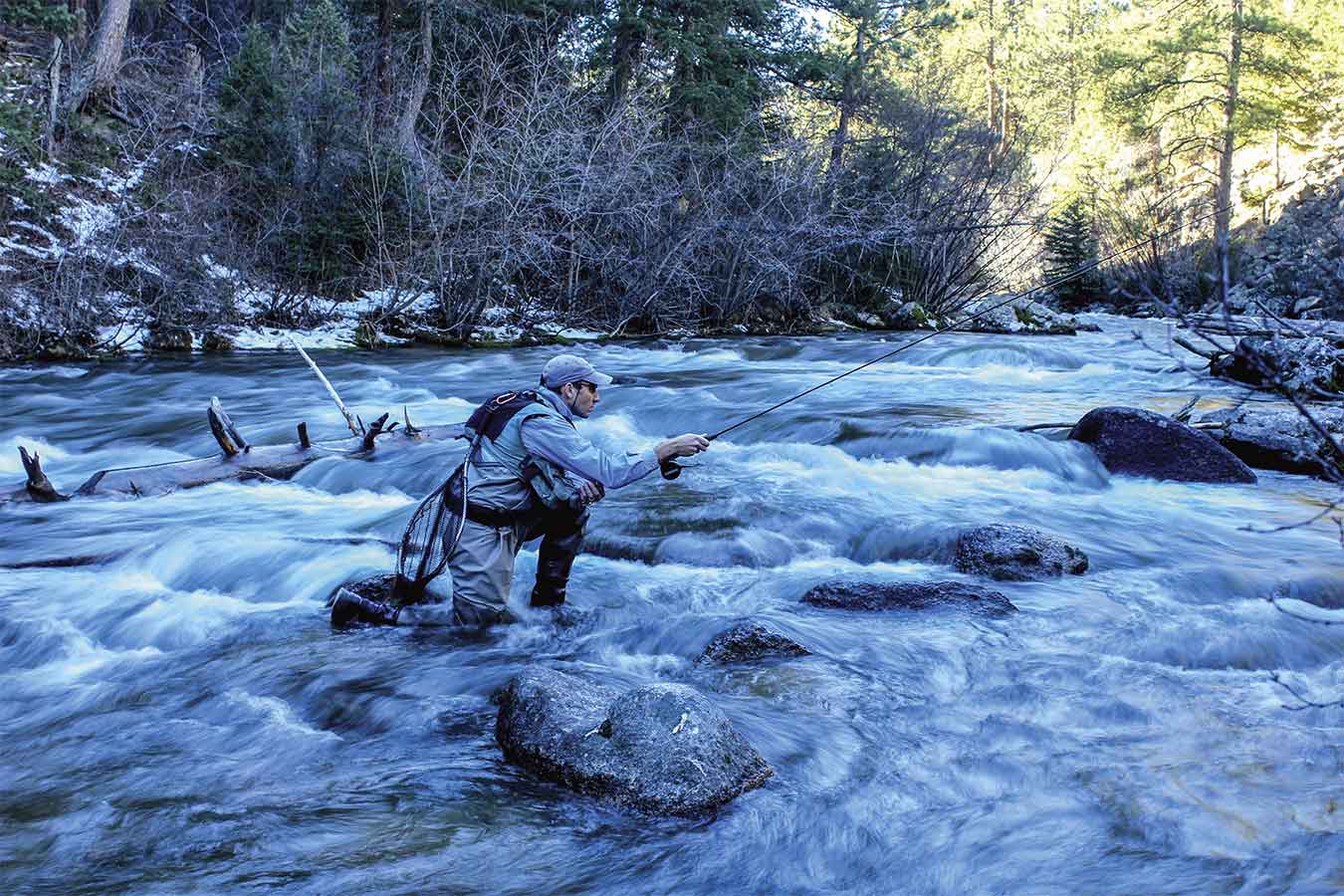
Though it may not look like good holding water, the area Antonio Rodrigues is fishing produced several fish in midwinter. By kneeling, he kept his profile low and his head and shoulders below the cone of vision of the trout he was targeting. If you can get past the extra effort and the odd looks from fellow anglers, kneeling will produce extra opportunities to catch unsuspecting trout when the water is clear and the fish are spooky.
魚がいる流れのように見えないけど、Antonio Rodriguesは真冬に数匹を釣り上げている。跪きながら、狙った鱒の円錐視野(コーン・ビジョン)の範囲外に頭と肩があるように姿勢を低く保った。もし君が過去に、仲間の釣人のガンバリと変わった姿勢を見ることがあったなら、跪きのスタイルは川の流れがクリアで魚が神経質なとき、魚に怪しまれないで釣るための特別なチャンスになる。
How do you avoid alerting fish to your presence? Here are five strategies I use to help prevent fish from seeing me and perceiving me as a threat.
君のプレゼンテーションはどうしたら魚を警戒させないか?次の点が、魚から君を見えなくして警戒させないための有益な5つの戦術だ。
Fish a Longer Rod
One way to avoid showing yourself to fish in clear water is to fish from a greater distance. A lot of the nymph fishing I do is based on Euro-nymphing methods. These techniques are inherently limited in their effective range. Many anglers start off Euro-nymphing with a 10-foot rod. However, one of the ways to increase your range is to fish a longer rod. My friend and former Fly Fishing Team USA mate Charlie Card spends much of his time fishing on his home water, Utah’s Green River. This is a techy tailwater river often referred to as “The Aquarium” because its clarity is unsurpassed, and trout can be spotted everywhere, including at the bottom of pools more than 20 feet deep. A while back, I asked Charlie what strategies he uses to adapt to fishing the Green when Euro-nymphing. One of his simplest is that he only Euro-nymphs with rods 11 feet and longer at this river. With the longer rod, he is able to increase his successful radius of presentation; sometimes only a foot or two extra is needed to make the difference between spooking a fish and catching it.
長い竿で釣れ
クリアーな流れで、魚から身を隠す1つの方法は魚から離れて釣ることだ。私が行っている多くのニンフ・スタイルはユーロ・ニンフをベースにしている。この技術の有効性は本来、ある範囲内に限定されている。大半の釣人は10フィート・ロッドでユーロ・ニンフィングを始める。私の友人であり、前フライフィッシング・チームUSAのメンバー、Charlie Cardは彼のホーム川であるUtah's Green川で、釣りに多くの時間を使っている。その川は、techyな放水でできた川で、たびたび水族館と呼ばれる。と言うのは、水質の良さは素晴らしく、鱒たちは水深20フィート以上のプールのどこにでも見つけることができる。先日( a while back)、彼にGreen川に合わせるためにユーロ・ニンフィングで使っている戦術は何か?と尋ねた。一番簡単なやり方は11フィート以上のロッドでユーロ・ニンフのみ使う方法だ。もっと長いロッドなら、プレゼンテーションの範囲がもっと広がる。ときどき、魚を脅かすことと魚を釣りあげるの違いは、わずか1か2フィートだけフライを遠くへ飛ばせるかどうかである。
When Euro-nymphing, your rod loosely forms the hypotenuse of adjacent right triangles. With a little trigonometry it’s possible to calculate the difference in reach between rods of different lengths. In short, an extra foot of rod leads to more than an extra foot of reach. When fishing large rivers or clear pressured rivers with spooky fish, a longer rod can mean the difference between catching fish and coming up short.
ユーロ・ニンフイングの場合、君のロッドは緩やかに隣接した2つの直角正三角形を形作る。簡単な三角法を用いると、異なった長さのロッドを使ったときの届く差を計算することができる。簡単に言うと、ロッドの長さの増加分は届く距離の増加分よりも大きい。川が大きいか、透明度が高くて警戒心の高い魚を釣るときは、より長いロッドは”釣れる”と”物足りない”の違いになる。
ユーロ・ニンフイングの場合、君のロッドは緩やかに隣接した2つの直角正三角形を形作る。簡単な三角法を用いると、異なった長さのロッドを使ったときの届く差を計算することができる。簡単に言うと、ロッドの長さの増加分は届く距離の増加分よりも大きい。川が大きいか、透明度が高くて警戒心の高い魚を釣るときは、より長いロッドは”釣れる”と”物足りない”の違いになる。
Use a Fishing Method Tailored to Distance Presentations
The other strategy for fishing farther away is choosing the proper technique and rig for the situation. In clear water, the distances required to avoid spooking fish can be significant if the water is smooth and the view between air and water is not obstructed by broken surface currents. In these situations, I often choose to forgo Euro-nymphing in favor of a longer-distance strategy.
遠投プレゼンテーションに合った釣り方法を使え
遠投の他の戦術は状況に適した技術と仕掛けを選ぶことだ。透明度の高い流れでは魚を怯えさせないように、もし流れがスムーズで水面の視界が荒れた波で邪魔されていないなら、魚を脅えさせないために距離が重要になる。
Let me provide an example. In the 2013 World Fly Fishing Championship in Norway, we fished the large, low-gradient Vefsna River. The weather turned warm and dry for several weeks leading up to the championship, and the river dropped and became very clear. The densities of fish were low in the river, and most sessions were won with less than 10 fish. When I arrived at the river during the championship, I found that 90 percent of my beat was a smooth, medium-velocity glide between 2 and 5 feet deep. While I could not spot fish, I could see the bottom easily, and knew the fish would see me.
1つ例を示そう。ノルウェイーで開催された2013年世界フライフィッシング・チャンピオンシップ大会で、大河であり低勾配のVefsna川で釣った。大会の数週間前、気温は上昇し、湿度は低く、川の水位も低くなって透明度が高かった。川の中の魚の密度は低く、大半の部門では10匹以下の釣果で優勝になっていた。大会の間に川に着いたとき、俺の持ち場(beat)の90%は2-5フィートの水深で、流れはスムーズで、中くらいの速さであることが分かった。魚を見つけることができなかったが川底は容易に確認できた。魚から此方が見えることも分かった。
Most of the competitors from other countries chose to fish wet flies swung on floating and clear intermediate lines, which worked well. However, I chose to rely on my suspension/strike-indicator nymphing background, and rigged a rod with a dry and tungsten nymph dropper to use the same approach, while staying within the FIPS-Mouche rules, which don’t allow floating devices on the leader other than flies. The dry fly was a large Chubby Chernobyl with extra yarn I added in the wing to increase the buoyancy and hold up heavy nymphs. I spent 90 percent of my session fishing this rig with a combination of dead drifts and twitches to move the dry fly. The grayling and brown trout fell hard for the duo, and I landed 16 fish for the session win, which was the highest number landed during any session of the championship. If I had stuck with the usual short-range Euro-nymphing approach, it’s possible I would have landed a few fish, but I doubt I would have been nearly as successful.
他の国から来た競争相手の大半はフローティングか、クリアーなインターミディエイト・ラインを使ってウェット・フライで釣ることを選択していて、うまくいっている。でも、私はインディケータ+ニンフィングを信頼し選択して、同じアプローチを使うためにドライとタングステン・ニンフ・ドロッパーを準備した。FIPS-Moucheルールに従ったけど、リーダにフライ以外の浮きを付けることは認められていない。そのドライ・フライは、浮力を高め、重いニンフを浮かすために、飛行中に加えてた特別のヤーンを付けた大型のChubby Chernoby 1であった。このドライを動かすためにデッドドリフトとトウィッチ(twitche)の組み合わせた仕掛けで、自分のセッションの90%を費やした。グレーリングとブラウンは二人(duo)に釣れ、私はこのセッションで16匹釣り上げ優勝した。その数はこの大会のどのセッションを通しても、もっとも高かった。もし通常のショートレンジのユーロ・ニンフ仕掛けでガンバッたなら、たぶん数匹加えただろうが、成功したかどうかは疑わしい。
他の国から来た競争相手の大半はフローティングか、クリアーなインターミディエイト・ラインを使ってウェット・フライで釣ることを選択していて、うまくいっている。でも、私はインディケータ+ニンフィングを信頼し選択して、同じアプローチを使うためにドライとタングステン・ニンフ・ドロッパーを準備した。FIPS-Moucheルールに従ったけど、リーダにフライ以外の浮きを付けることは認められていない。そのドライ・フライは、浮力を高め、重いニンフを浮かすために、飛行中に加えてた特別のヤーンを付けた大型のChubby Chernoby 1であった。このドライを動かすためにデッドドリフトとトウィッチ(twitche)の組み合わせた仕掛けで、自分のセッションの90%を費やした。グレーリングとブラウンは二人(duo)に釣れ、私はこのセッションで16匹釣り上げ優勝した。その数はこの大会のどのセッションを通しても、もっとも高かった。もし通常のショートレンジのユーロ・ニンフ仕掛けでガンバッたなら、たぶん数匹加えただろうが、成功したかどうかは疑わしい。
Use Naturally Occurring Obstructions to Shield You from the Fish
An often-overlooked way to minimize your chances of spooking fish is to use obstructions to block a trout’s view of your body or to blend into your surroundings. One of my favorite examples of this strategy comes from Gary Lafontaine. In his book Fly Fishing the Mountain Lakes, Gary shared a story about how he caught a wise old brown trout from a friend’s pond. In his first few encounters, Gary noticed that the fish would cruise its established path until swerving out into the pond after noticing Gary fishing from the bank. Gary placed an artificial tree on the bank near where the fish had established its territory and allowed the brown trout to become accustomed to it. On a subsequent trip, he used the tree to hide behind. As a result, he avoided signaling himself as a threat and easily caught the trout.
魚から自然に隠れる障害物を使え
魚を怯えさせる可能性を最小限にする見逃しがちな方法は、魚の視界をブロックする障害物を使うか、または周辺に溶け込むことだ。この方法の好きな例の1つがGary Lafontaineのものだ。彼の本Fly Fishing the Mountain Lakesの中で、友人所有の池で老練で狡猾なブラウンをどのようにして釣ったか、Garyは披露している。彼は最初のわずかな時間で、魚はGrayが岸から釣りしていることに気づき、彼が池を離れるまで、決まったパスを巡回している、ことを理解した。彼は魚がテリトリーとして定着していた近くの岸に、人工の樹木を置き、魚をそれに慣れさせた。次の旅行のとき、彼は身を隠すためにその樹木を利用した。そして脅威としてのシグナルを消すことで、鱒を簡単に釣り上げた。
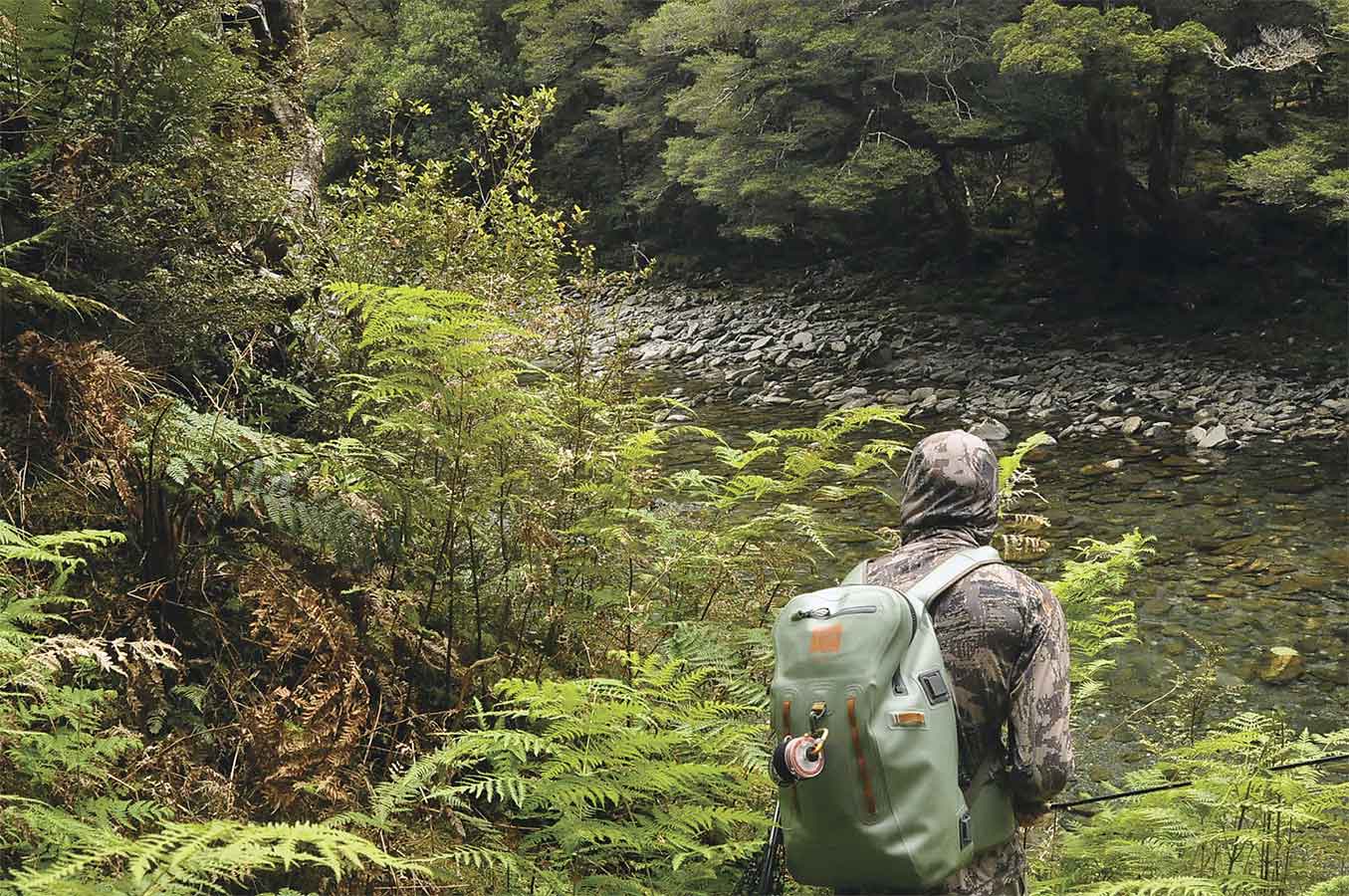
Anglers in New Zealand are known for wearing camouflage to hide their presence when stalking trout. Whether you sport full camo or not, avoid wearing bright colors, especially on your head and neck, and you will be able to approach more trout without spooking them. (PHOTO BY CONNOR MURPHY)
ニュージーランドからの釣人は、鱒に気づかれないように接近するとき、自分の存在感を消すためにカモフラージュを着用することが知られている。完全にカモフラージュするかしないかに関係なく、明るい色を、特に帽子と首に、身につけるのを避けよ。これで魚を警戒させないで接近することが可能になる。
This story illustrates a strategy that few anglers use on the river. The fact is, there can be lots of types of obstructions to use while you’re on the river. The obvious ones are physical objects like rocks and trees. When placed between yourself and the fish, these objects can break up your outline just like the artificial tree did for Gary Lafontaine. If I’m fishing pocketwater, I will kneel on, lean on, or crouch behind available boulders that will help to break my silhouette and allow me to get closer to my target lie, or fish. I also look for dead trees hanging out over the river that I can use the same way.
この話では、ほとんどの釣り人が使わない戦術を図解している。実は、川にはたくさんの利用可能な障害物がある。分かり易い例が、岩と樹木のような物理的な物である。君と魚の間にそれがある場合、Grayが述べた人工の樹木のように君の輪郭(profile)を分解(break up, 解体)するだろう。私がもしポケットウォータを釣っているなら、跪き、自分のシルエットを壊し、魚か隠れ場に近づくために利用できる大岩の後ろで屈む(かがむ)つもりだ。また同じやり方で、川にはみ出した利用可能な古木を探す。
この話では、ほとんどの釣り人が使わない戦術を図解している。実は、川にはたくさんの利用可能な障害物がある。分かり易い例が、岩と樹木のような物理的な物である。君と魚の間にそれがある場合、Grayが述べた人工の樹木のように君の輪郭(profile)を分解(break up, 解体)するだろう。私がもしポケットウォータを釣っているなら、跪き、自分のシルエットを壊し、魚か隠れ場に近づくために利用できる大岩の後ろで屈む(かがむ)つもりだ。また同じやり方で、川にはみ出した利用可能な古木を探す。
The current itself is often the best and easiest veil to hide behind. When the surface of the river is broken enough to hide the riverbed, I place this current in between myself and my target lie, just like it was a tree or rock. If you force the fish to look through broken current, either they won’t be able to see you, or their view will be broken enough that they won’t consider you a threat. A common example of this strategy is fishing from a wading position in the river to the lies on the far bank. When there are waves and broken water running between you and your target lie, they will hide your outline and allow you to cut the distance between you and the trout you’re after. When you can fish closer to your target, you can reduce the slack in your presentation, improve your strike detection and deadness of your drift, and quicken your hook-set reaction time.
しばしば川の流れそれ自身が、その後ろに隠れるための簡単ないい保護物になる。川底を十分隠すくらいに水面が波立っているなら、岩や樹木のように、自分と魚が潜む場所の中間に川の流れがくるようにする。もし波立った流れを通して魚に見させるなら、魚から君は見えないか、怖がらない程度に魚の視界が壊れていることだろう。この戦術のありふれた例は川をウェーディング位置から遠くの川岸の魚の隠れ場へ釣ることだ。川の流れに波があったり砕けた流れなら、君の輪郭は隠されるので魚までの距離を縮めることが可能だ。ターゲットの近くで釣りが可能な場合、君のプレゼンテーションの、ラインの弛みを減らすこと、アタリの捕り方、ドリフトのスピード、そしてアタリに対する反応時間を改善せよ。
しばしば川の流れそれ自身が、その後ろに隠れるための簡単ないい保護物になる。川底を十分隠すくらいに水面が波立っているなら、岩や樹木のように、自分と魚が潜む場所の中間に川の流れがくるようにする。もし波立った流れを通して魚に見させるなら、魚から君は見えないか、怖がらない程度に魚の視界が壊れていることだろう。この戦術のありふれた例は川をウェーディング位置から遠くの川岸の魚の隠れ場へ釣ることだ。川の流れに波があったり砕けた流れなら、君の輪郭は隠されるので魚までの距離を縮めることが可能だ。ターゲットの近くで釣りが可能な場合、君のプレゼンテーションの、ラインの弛みを減らすこと、アタリの捕り方、ドリフトのスピード、そしてアタリに対する反応時間を改善せよ。
If you can’t find turbulent water or a physical object to put in between yourself and the fish, another strategy to try is blending into your surroundings. If you have ever seen photos of anglers from New Zealand, or have taken a trip there, you will likely notice a lot of anglers wearing camouflage. While this may seem overzealous to some, they deal with the difficulties of spooky trout in clear water on a daily basis, and use any strategy they can to reduce the trout’s perception of them as a threat. You may not need to dress fully like an archery hunter to avoid spooking fish on your local river, but I’m convinced it can pay dividends to dress in drab colors that don’t stand out drastically from the vegetation in the riparian zone. This is particularly important when it comes to hats or shirts, since the parts of your body fish are most likely to see first are your head, shoulders, neck, and outstretched arms.
もし君と魚の間に、川の流れの乱れや物体が無いのなら、他の戦術は周辺の環境に解け込むことである。君がニュージーランド出身の釣人の写真を見たことがあるか、そこへ旅行したことがあるなら、カモフラージュを着たたくさんの釣人にきっと気がづくだろう。これはある人にはやり過ぎ(overzealous)と見えるかも知れないが、彼らは日常的に透明度の高い川で神経質な鱒を釣る難しさを経験していて、鱒の警戒心を減らす戦術を使うのだ。君の地元の川で魚を警戒させないために、アーチェリーハンターのような完全防備の服装は必要ないが、川辺の草むらで目立たないようなくすんだ色の服装をすることが釣果を生む、と確信している。この点は帽子とシャツにおいて、特に重要だ。と言うのは、魚がまず目にしそうな君の体の部分は、頭、肩、首、そして伸ばした腕だからだ。
もし君と魚の間に、川の流れの乱れや物体が無いのなら、他の戦術は周辺の環境に解け込むことである。君がニュージーランド出身の釣人の写真を見たことがあるか、そこへ旅行したことがあるなら、カモフラージュを着たたくさんの釣人にきっと気がづくだろう。これはある人にはやり過ぎ(overzealous)と見えるかも知れないが、彼らは日常的に透明度の高い川で神経質な鱒を釣る難しさを経験していて、鱒の警戒心を減らす戦術を使うのだ。君の地元の川で魚を警戒させないために、アーチェリーハンターのような完全防備の服装は必要ないが、川辺の草むらで目立たないようなくすんだ色の服装をすることが釣果を生む、と確信している。この点は帽子とシャツにおいて、特に重要だ。と言うのは、魚がまず目にしそうな君の体の部分は、頭、肩、首、そして伸ばした腕だからだ。
Lower Your Elevation and Profile
Keep repeating the mantra, “If I can see the bottom or the fish, they can see me.” As you wade into position to fish a lie, think about your position and your height. If where you plan to wade puts your head high above the water, fish are more likely to see you. If you can wade into a depression between rocks or step off a gravel bar or shelf into deeper water, you will diminish your presence to the fish.
姿勢と輪郭の度合いをより下げろ
スローガン「川底か魚が見えるなら、魚は君を見ている」を繰り返せ。魚が潜む場を釣るためにウェーディングするとき、自分の位置と高さを考えろ。もしウェーディングする場所が、君の頭を水面から高くするなら、魚が君を見る可能性は高い。もし岩の間の窪地をウェーディングするか、砂利洲か深場の棚(shelf)を降りることができるなら、魚に対しての君の存在を消すことができる。
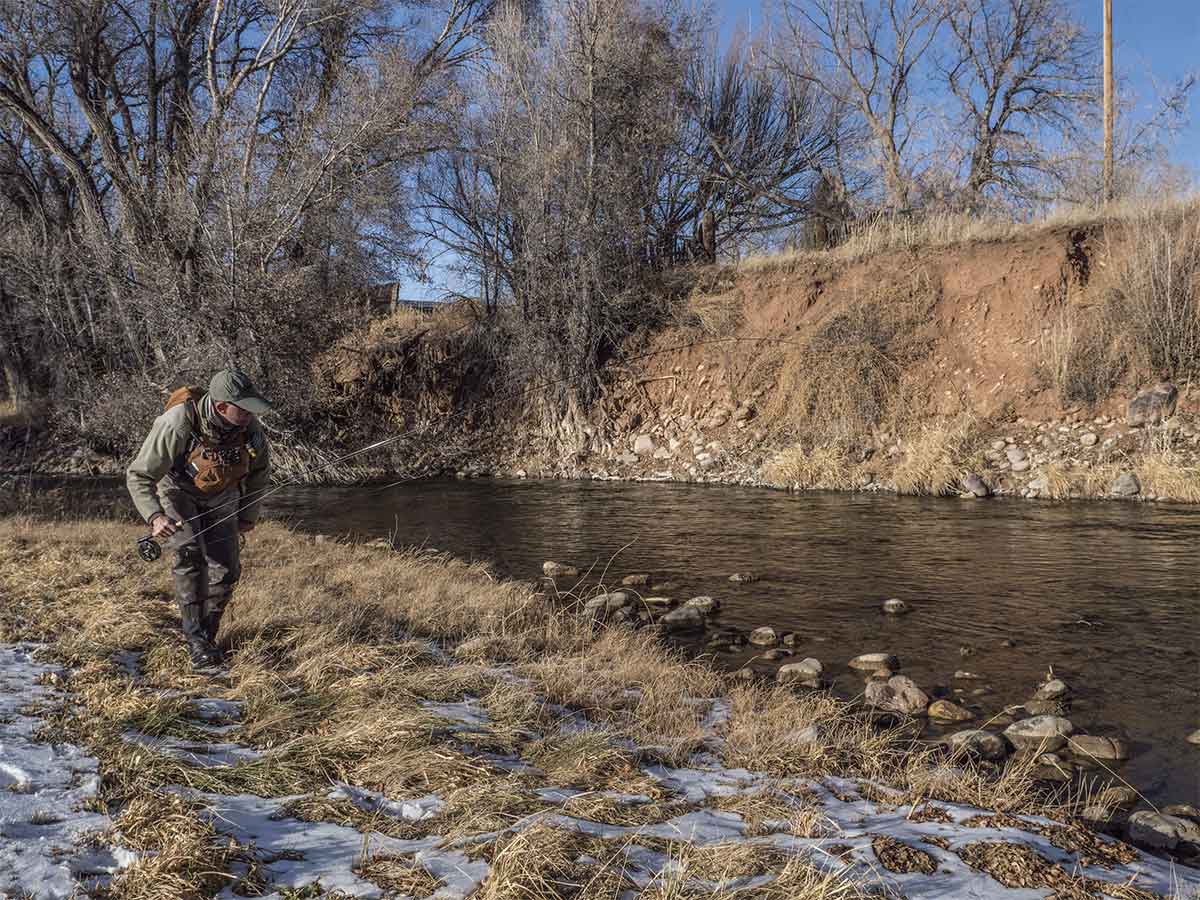
Keeping your shadow off the water you plan to fish is critical to avoid alerting trout to your presence. In this photo, Lance Egan gets into fishing position by crouching. The low afternoon sun angle on this December day cast long shadows; by keeping his shadow off the water, Lance avoided spooking the fish he was about to catch.
釣ろうとしている水面に自分の影を落とさないことは、魚を怖がらせないために重要である。この写真ではLance Eganが前屈みで釣り場に向かっている。今年の12月の午後、日が低くなって長い影ができている。水面に影を落とさないことで、釣ろうとしている魚をLanceは警戒させなかった。
This is a common problem when fishing from an inside bend. These locations are deposition zones for the river, and flooding flows often deposit gravel or cobble that forms a steep slope. A single step toward the center of the river may lower your profile 6 to 12 inches in these types of locations. Even though stepping into the river will put you closer to your intended lie, the reduced height may decrease the angle between you and the water’s surface sufficiently for you to get under the cone of vision of the trout you are pursuing. Be cognizant of your casts as well. Many of the best dry-fly anglers I know make sidearm casts to keep their line close to the water and out of view of the trout.
川の内側の曲がりから釣るとき、これは一般的な問題になる。その場所は川に対して堆積物のある場所になっているからだ。しばしば洪水が傾斜を形成する砂利や小石を堆積させる。川の中心へ向かう1つの段差は、このタイプの場所では、君の輪郭を6から12インチ下げるかもしれない。川へ立ち入ることは、魚が潜む狙った場所へ近づくけれども、低くなった君の高さは、魚の円錐視野の十分下になり、君と水面間の角度を小さくする。同様に、君のキャストについても認識しているか。私の知っている上手いドライ・フライの釣人の多くは水面にフライラインを近づけて、鱒の視野から外れるためにサイドアーム・キャストを使う。
川の内側の曲がりから釣るとき、これは一般的な問題になる。その場所は川に対して堆積物のある場所になっているからだ。しばしば洪水が傾斜を形成する砂利や小石を堆積させる。川の中心へ向かう1つの段差は、このタイプの場所では、君の輪郭を6から12インチ下げるかもしれない。川へ立ち入ることは、魚が潜む狙った場所へ近づくけれども、低くなった君の高さは、魚の円錐視野の十分下になり、君と水面間の角度を小さくする。同様に、君のキャストについても認識しているか。私の知っている上手いドライ・フライの釣人の多くは水面にフライラインを近づけて、鱒の視野から外れるためにサイドアーム・キャストを使う。
In addition, a lot of anglers overlook the position of their shadow as they approach the river. There is no better way to send trout scurrying for cover quickly than a shadow cast across their holding lie. If you have ever watched trout holding in a pool as a bird of prey flies over and casts a shadow on the water, you have likely seen the instant panic that ensues. As you approach the water, pay close attention to where your shadow extends, especially when the sun is at low angles during the day and your shadow is longer. Crouch to get into position if necessary and you will find more fish still willing to eat when you make your first cast.
加えて、川に接近するとき、多くの釣り人は自分の影を見落としている。魚が潜んでいる隠れ場に影を落としてキャストすること以上の、カバーに鱒を素早く逃げさせる方法はない。もし君が、猛禽類が上空を飛んで水面に影を落としたときに、プールに定位している鱒を見たことがあるなら、魚が直ぐにパニックになったことを見たことがあるだろう。川に接近するとき、特に、太陽が低く、影がより長くなる時間帯は、自分の影の伸びる方向に注意せよ。必要なら目的の地点に着くとき、かがめ(屈め)。そうすれば、最初のキャストで、まだ食い気のある魚をもっとたくさん見つけるだろう。
加えて、川に接近するとき、多くの釣り人は自分の影を見落としている。魚が潜んでいる隠れ場に影を落としてキャストすること以上の、カバーに鱒を素早く逃げさせる方法はない。もし君が、猛禽類が上空を飛んで水面に影を落としたときに、プールに定位している鱒を見たことがあるなら、魚が直ぐにパニックになったことを見たことがあるだろう。川に接近するとき、特に、太陽が低く、影がより長くなる時間帯は、自分の影の伸びる方向に注意せよ。必要なら目的の地点に着くとき、かがめ(屈め)。そうすれば、最初のキャストで、まだ食い気のある魚をもっとたくさん見つけるだろう。
If the water is less than knee-deep or if I’m fishing from the bank, I will often fish from my knees. During the session on the Pliva River in Bosnia I described earlier, the only way I could approach the fish I spotted was from dry land on the bank they were holding by. Heavy water in the middle of the channel prevented an across-theriver approach. I spent two and a half of my three hours in that session fishing from my knees on the bank. I firmly believe I would not have caught any fish had I been standing over them.
もし水位が膝下か川岸から釣っているのなら、私はときどき両膝をついて釣る。先に説明したようにボスニアのPliva川でのセッションの間、狙った魚に接近するたった1つの方法は魚が潜む場所の近くの岸から、であった。川の中央のトルクフルな流れは渡河できない状態だった。川岸で両膝をついた釣りに2時間半費やした。しかし、立って釣っていたなら1匹も釣れなかったろうと思う。
もし水位が膝下か川岸から釣っているのなら、私はときどき両膝をついて釣る。先に説明したようにボスニアのPliva川でのセッションの間、狙った魚に接近するたった1つの方法は魚が潜む場所の近くの岸から、であった。川の中央のトルクフルな流れは渡河できない状態だった。川岸で両膝をついた釣りに2時間半費やした。しかし、立って釣っていたなら1匹も釣れなかったろうと思う。
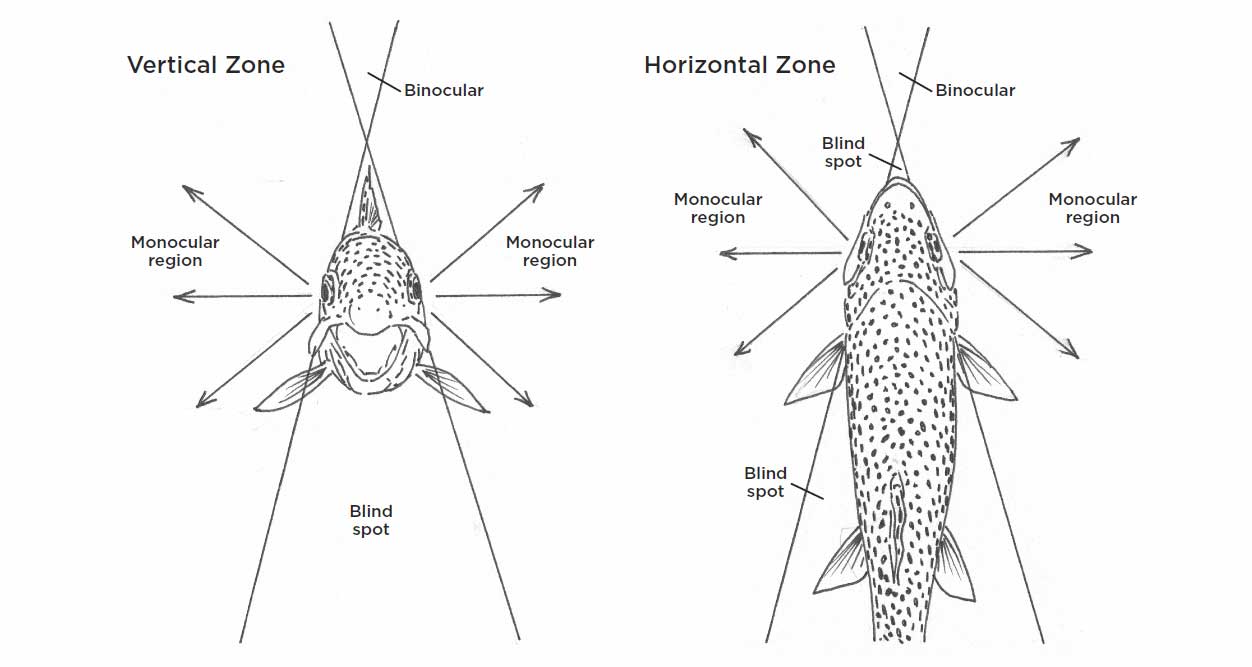
The location of its eyes allows a trout to see much of the world around it in binocular or monocular vision. However, there is one blind spot behind its head where you can approach it and stay out of sight.
魚の目は両眼、または単眼で、目の周りの世界をよりたくさん見れるようになっている。でも、頭の背後に1つの盲点がある。そこは君が魚に接近しているとき、視界の範囲外になる点である。
A similar strategy paid dividends during the 2011 National Fly Fishing Championship in North Carolina. I drew a beat on the Nantahala River in my final session that had produced poor results for other anglers in the previous four sessions. When I scouted the beat, there was a long section (80–100 yards) of shallow pocketwater at the bottom, which was difficult to approach in the low, clear flows. However, the temperatures were prime, and I thought there would be fish that hadn’t been bothered by other competitors in this less-prime-looking water.
同様の戦術がノースカロナイナ州で開催された2011年全国フライフィッシング大会で実を結んだ。他の釣り人が先の4セッションで良い結果を出せなかった私の最終セッションで、Nantahala川の持ち場(beat)で引き分けになった。その持ち場を偵察したとき、川底に長さ80-100ヤードの浅いポケットウォータ区間があって、水位が低く、透明度のある流れであり、魚に接近することが難しかった。しかし、気温が最も重要で、重要に見えない流れの競合者によって、邪魔されていない魚がいると思った。
I spent the first two hours of my session on my knees slithering from rock to rock. Trout came easily in the turbulent yet shallow water. They were much harder to fool in the obvious pools and deep pockets above, which earlier competitors had likely targeted heavily. Though I did not win the session, I was able to get a third place on a tough beat, which was good enough to secure a silver individual medal for the championship. If I had taken the road heavily traveled in the deep pools and obvious pockets, my finish would have been much worse. Instead, a low-profile approach, to water that was prime for the river conditions, produced results.
岩から岩へ屈んで跪き、自分のセッションに最初2時間費やした。波打っているが浅瀬の流れから鱒がすぐ出てきた。鱒たちはハッキリしたプールの中と深場のポケットの上を動き回るのが非常に難しかった。そこはライバルたちがすでにかなり釣り試したようだった。このセッションで優勝しなかったが、tough beatで3位に入った。この大会で銀メダルを手にするのに十分な成績だった。もし深場のプールと露出したポケットを苦労して遡行する道を取っていたら、私の結果はもっと悪いものになっていたであろう。代わりに、川の状態が重要な水域に、低姿勢アプローチ(low-profile approach)が成果に結びついたのだ。
岩から岩へ屈んで跪き、自分のセッションに最初2時間費やした。波打っているが浅瀬の流れから鱒がすぐ出てきた。鱒たちはハッキリしたプールの中と深場のポケットの上を動き回るのが非常に難しかった。そこはライバルたちがすでにかなり釣り試したようだった。このセッションで優勝しなかったが、tough beatで3位に入った。この大会で銀メダルを手にするのに十分な成績だった。もし深場のプールと露出したポケットを苦労して遡行する道を取っていたら、私の結果はもっと悪いものになっていたであろう。代わりに、川の状態が重要な水域に、低姿勢アプローチ(low-profile approach)が成果に結びついたのだ。
Approach Fish from Downstream to Avoid Being Seen
The anatomical position of a trout’s eyes allows it a cone of monocular vision on the sides and binocular vision in the front, but it has a blind spot directly downstream. If you stay in that blind spot, the trout won’t be able to see you until your proximity becomes too close.
魚に気付かれない下流からの接近
鱒の目の解剖学的位置は側面で単眼の円錐形と前面で両眼視ができるようになるが、ちょうど下流側に1つの盲点がある。君がその盲点にいたなら、君がもっと近づくいても、鱒は君を見ることができない。
My teammate Pat Weiss is a master of fishing upstream to trout. Reading back through my journals of the competitions we’ve fished together over the past few years, my comments from our practice sessions repeatedly refer to how well Pat fishes from a downstream position. It’s become clear to me that there are many instances where I could incorporate this strategy more regularly into my own approach. Like George Daniel, Pat hails from State College, Pennsylvania, the capital of tuck casting and the upstream tight-line nymphing techniques made famous by Joe Humphreys and George Harvey. This region features a lot of lower-gradient trout rivers with flatter sections that make it difficult to avoid spooking fish when employing an across-the-river approach, except in higher flows.
私のチームメイトPat Weissは鱒の上流釣りの名人だ。過去数年間一緒に釣ってきたこの大会の記事を読み直しみて、我の実践部門からのコメントは、Patが下流から釣る方法を何度も参考にしている。その戦術を自分の川への接近方法に組み込むことができそうな沢山の事例はあることが、私には分かった。George Danielのように、Joe Humphreysとgeorge Harveyによって有名になったタック(tuck)キャストと上流からのタイトライン・ニンフィング技術の都、ペンシルバニア州のState CollegeからPatは歓迎された。この地域は、水位が高いとき以外で渡河による接近を使う場合、魚を怯えさせないことは難しい、平らな区間のある沢山の低傾斜の鱒川の特徴を持っている。
私のチームメイトPat Weissは鱒の上流釣りの名人だ。過去数年間一緒に釣ってきたこの大会の記事を読み直しみて、我の実践部門からのコメントは、Patが下流から釣る方法を何度も参考にしている。その戦術を自分の川への接近方法に組み込むことができそうな沢山の事例はあることが、私には分かった。George Danielのように、Joe Humphreysとgeorge Harveyによって有名になったタック(tuck)キャストと上流からのタイトライン・ニンフィング技術の都、ペンシルバニア州のState CollegeからPatは歓迎された。この地域は、水位が高いとき以外で渡河による接近を使う場合、魚を怯えさせないことは難しい、平らな区間のある沢山の低傾斜の鱒川の特徴を持っている。
Pat has adjusted his style to master lower-gradient rivers. He uses a Euro-nymphing leader specifically built with a thicker sighter so that it will float and suspend lightly weighted nymphs for an extended upstream drift. He prefers a fast 10-foot, 4-weight rod to assist in his complete command of the tuck cast, as opposed to the softer rods typically used by most Euro-nymphing anglers.
Patは彼のスタイルを低傾斜の川に調整した。彼は特に細い目印ライン(sighter)を組み込んだユーロ・ニンフ用リーダーを使う。それで、上流への延長ドリフトに対して軽いオモリ付ニンフを浮かしたり吊すのだ。完璧なタックキャストをアシストするロッドはファーストアクションの10フィートの#4を好み、大半のユーロ・ニンフ釣り師が使うより柔らかいロッドの反対である。
Patは彼のスタイルを低傾斜の川に調整した。彼は特に細い目印ライン(sighter)を組み込んだユーロ・ニンフ用リーダーを使う。それで、上流への延長ドリフトに対して軽いオモリ付ニンフを浮かしたり吊すのだ。完璧なタックキャストをアシストするロッドはファーストアクションの10フィートの#4を好み、大半のユーロ・ニンフ釣り師が使うより柔らかいロッドの反対である。

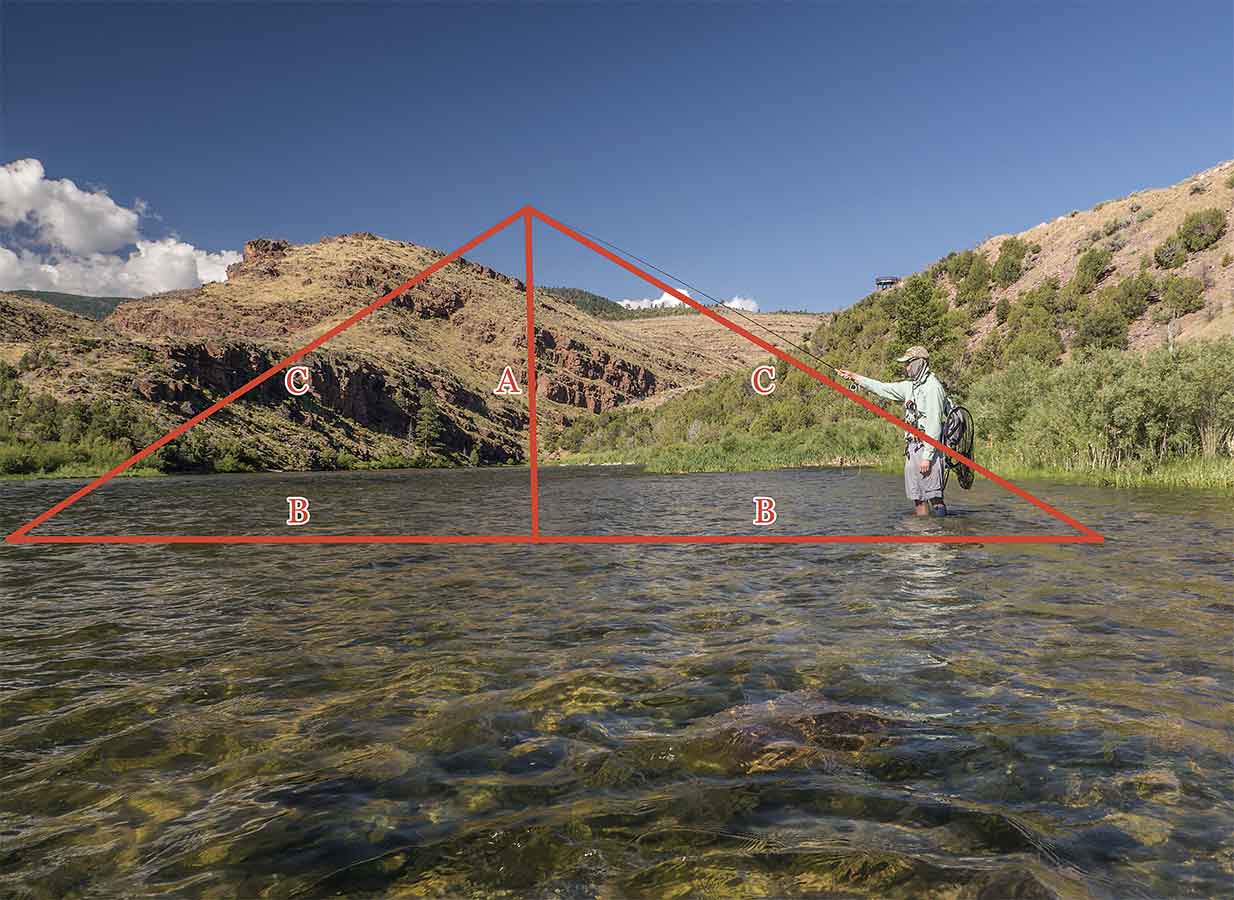
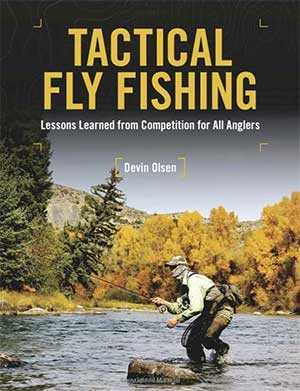
0 件のコメント:
コメントを投稿